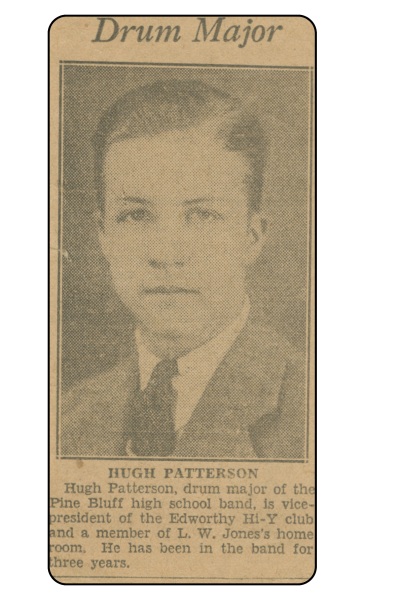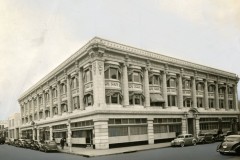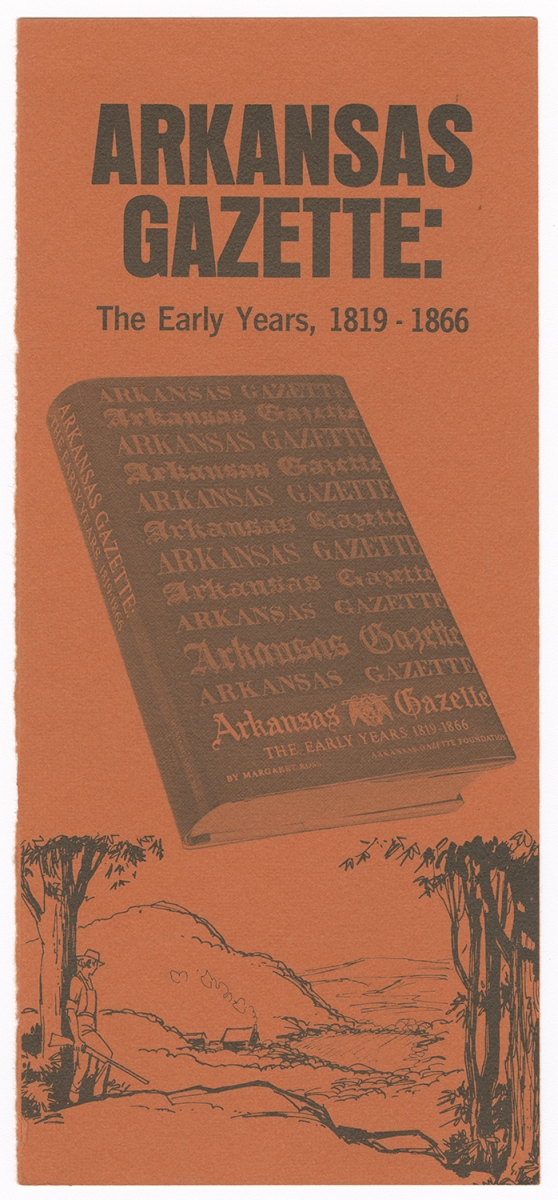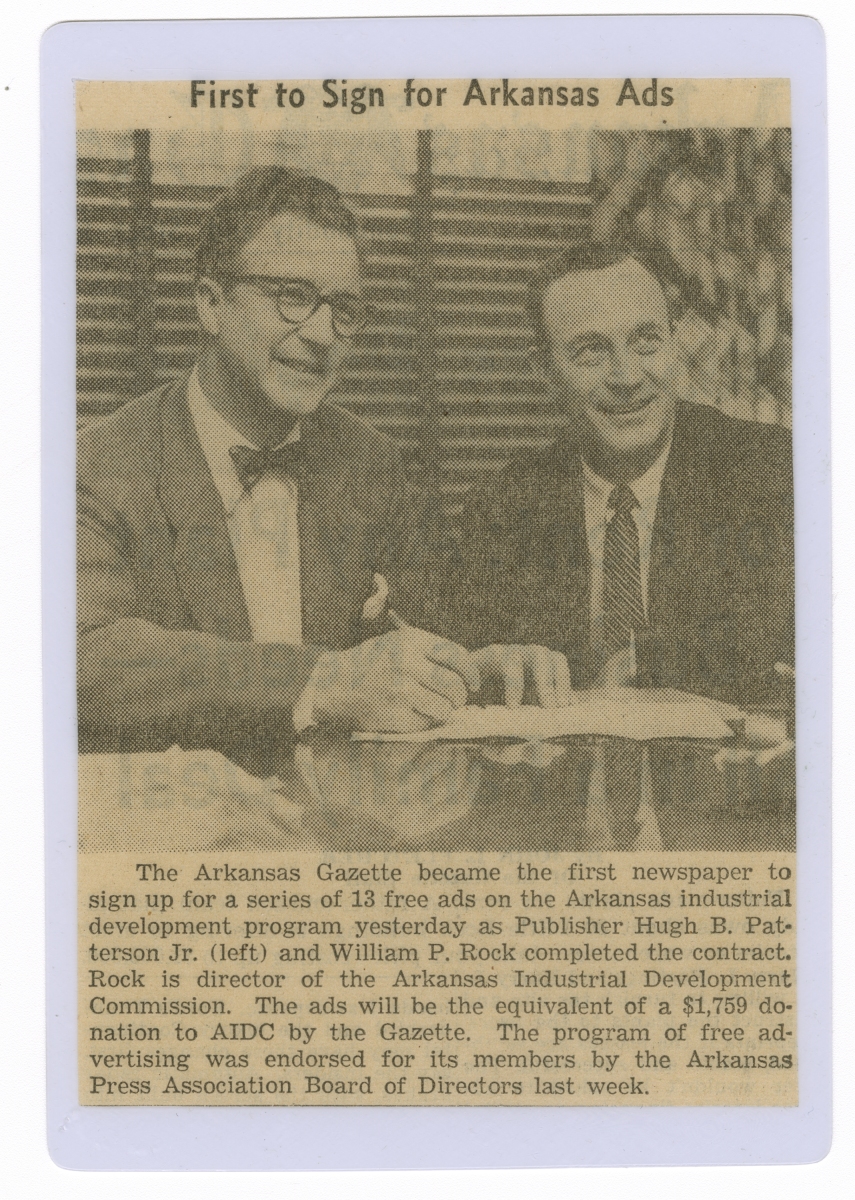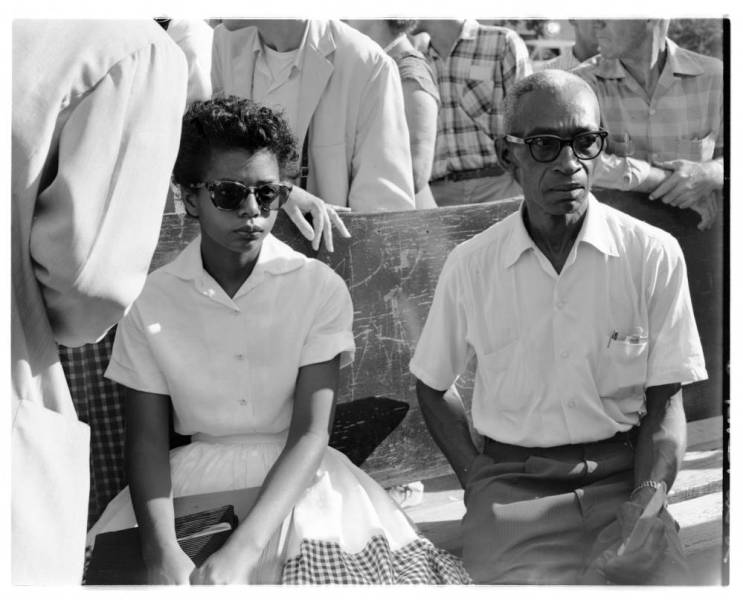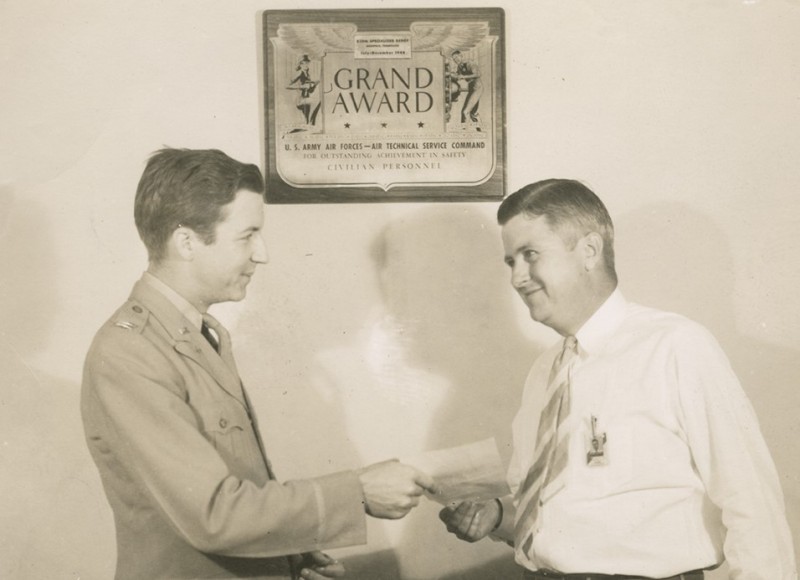Hugh Patterson JR.
Hugh B. Patterson Jr's principled leadership of the Arkansas Gazette during the 1957 Little Rock desegregation crisis shaped the public discourse on civil rights and set a powerful example of journalistic integrity in the face of societal pressure.
Hugh Patterson JR. IN THE NEWS
Hugh Baskin Patterson Jr. was born on February 7, 1915, in Cotton Plant, Mississippi. His family moved to Russellville and then to Pine Bluff, where Patterson attended public school and was the prize-winning drum major of the Pine Bluff High School band.
His journey to becoming one of Arkansas’s most influential newspaper publishers began in the depths of the Great Depression. As a young man, Patterson showed an early aptitude for business and communication, working in commercial printing and studying at Henderson State Teachers College. The economic hardships of the 1930s forced Patterson to cut his formal education short, but they also honed his resilience and resourcefulness. In 1933, at just 18 years old, he purchased his first car, a 1931 Chevrolet, for $75 on credit and embarked on a career selling printing supplies across Arkansas and Louisiana. This experience gave him invaluable insights into the printing industry and the diverse communities of the South.
Patterson’s career took a significant turn when he joined the U.S. Army Air Forces during World War II. He was commissioned as an officer and played a major role in leading the Air Corps training and maintenance depot at Mobile, Alabama, for the duration of the war.
Patterson’s career took a significant turn when he joined the U.S. Army Air Forces during World War II. He was commissioned as an officer and played a major role in leading the Air Corps training and maintenance depot at Mobile, Alabama, for the duration of the war. He specialized in supply and maintenance management, skills that would later serve him well in modernizing newspaper operations. Rising to the rank of major, he also won citations for the excellence of the Mobile facility and its use of civilian employees.
It was during his military service that Patterson’s life intertwined with the legacy of the Arkansas Gazette. Before the end of World War II around 1943, he married Louise Heiskell, daughter of J. N. Heiskell, the Gazette’s editor and principal owner.
Returning from the war, Patterson joined the Arkansas Gazette in 1946 as the National Advertising Manager and later became the Assistant Business Manager. Originally, J. N. Heiskell intended for his son Carrick White to continue the family’s leadership of the Gazette, but Carrick died in the war. Recognizing Patterson’s business sense and leadership potential, Heiskell decided to groom him for a greater role. As a result, in 1948 at the age of 33, Hugh B. Patterson Jr. became the publisher of the Arkansas Gazette.
MODERNIZING THE "OLD GRAY LADY"
As publisher, Patterson brought a fresh perspective to the newspaper, known affectionately as the “Old Gray Lady.” He embarked on an ambitious modernization program that touched every aspect of the newspaper’s operations.
Understanding that a newspaper’s success hinged on both its content and its business operations, Patterson implemented cutting-edge accounting systems that became models for the industry. He upgraded the Gazette’s equipment, bringing in modern printing presses that improved the quality and speed of production. These technological advancements allowed the paper to expand its content, adding new sections, stock tables, and even color comics to appeal to a broader readership.
Patterson’s business sense extended beyond the newspaper’s day-to-day operations. He successfully consolidated ownership of the Gazette under the Heiskell family, ensuring its independence and commitment to local interests. This move proved crucial in maintaining the paper’s editorial integrity in the face of future challenges.
But perhaps Patterson’s most significant contribution during this period was his talent for recruiting and retaining exceptional journalists. Under his leadership, the Arkansas Gazette became a magnet for bright young reporters and editors from across the country. Many would go on to illustrious careers at prestigious publications like the New York Times, but not before contributing to the Gazette’s reputation for excellence in journalism.
These modernization efforts positioned the Arkansas Gazette as a leading voice in the state, respected for both its journalistic quality and its business practices. Little did Patterson know that this solid foundation would soon be tested in ways he could never have imagined.
Desegregation and Standing Firm: The 1957 LITTLE ROCK CRISIS
The year 1957 put Hugh B. Patterson Jr. and the Arkansas Gazette into the national spotlight. The U.S. Supreme Court’s landmark Brown v. Board of Education decision in 1954 set the stage for school desegregation across the country, and Little Rock became a flashpoint in this struggle for civil rights.
As tensions mounted over the integration of Little Rock Central High School, Patterson found himself at a crossroads. The easy path would have been to remain silent or even side with the segregationists, as many Southern newspapers did. Instead, Patterson chose to stand on principle, supporting desegregation and the rule of law.
This decision was not made lightly. Patterson later recalled a pivotal family dinner where he and his wife Louise convinced her father, J. N. Heiskell, that supporting desegregation was not just right for the paper, but for the future of their grandchildren and Arkansas as a whole.
Under Patterson’s leadership, and with the powerful editorials of executive editor Harry Ashmore, the Gazette became a voice of reason in a period of hysteria. When Governor Orval Faubus called out the Arkansas National Guard to prevent nine Black students from entering Central High School, the Gazette stood firm in its criticism of this defiance of federal law.
The backlash was swift and severe. Thousands of readers canceled their subscriptions, and advertisers fled under pressure from segregationist groups. The Citizens Council, a non-profit organization working to improve education in the United States, pressed for an advertising boycott, threatening the paper’s very existence. Yet Patterson remained stoic, understanding that the principles at stake were far more important than short-term financial considerations.
His steadfast leadership during this crisis not only kept the Gazette afloat but also earned it national recognition. In 1958, the paper was awarded two Pulitzer Prizes: one for Public Service and another for Editorial Writing. These awards validated Patterson’s principled stance and cemented the Gazette’s place in civil rights history.
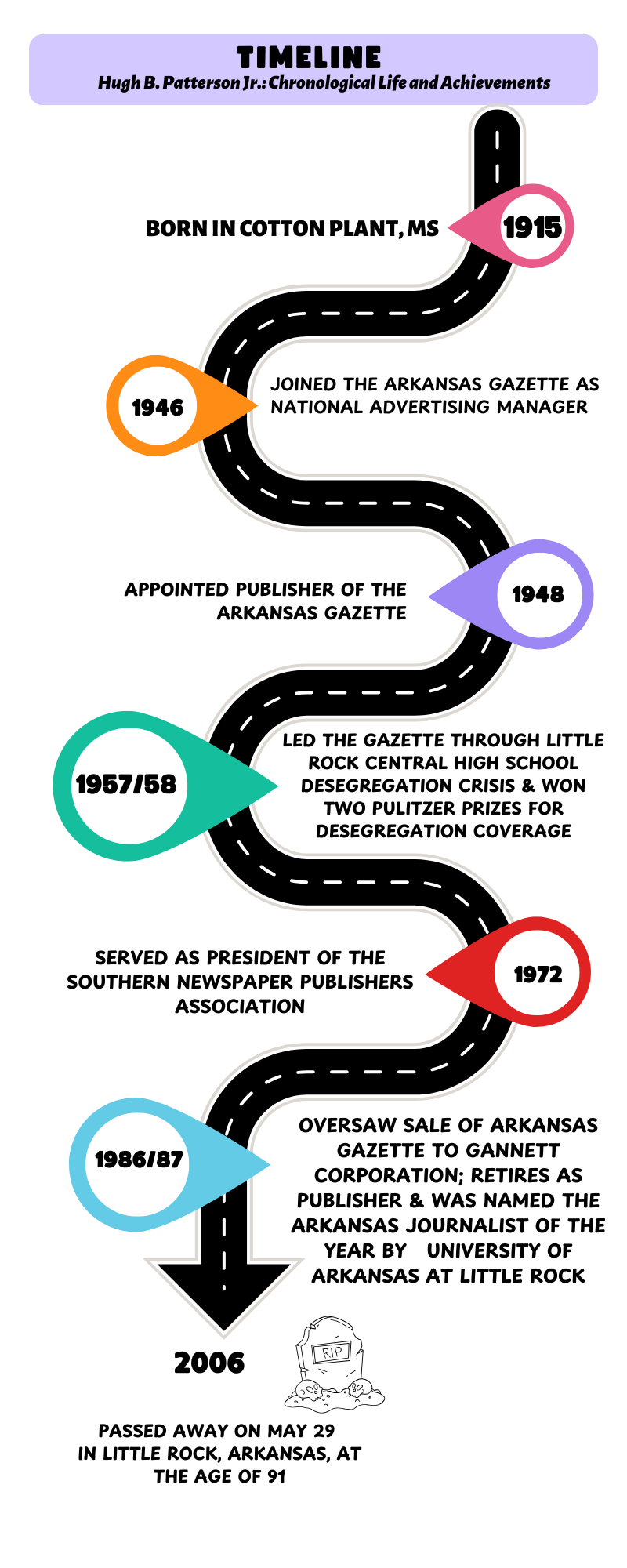
Hugh B. Patterson Jr.’s courageous leadership during the Little Rock crisis left a permanent mark on Arkansas and the field of journalism. His actions demonstrated the power of a free press to speak up for the public and stand up for democratic principles, even in the face of overwhelming opposition.
In the years following the crisis, Patterson continued to guide the Gazette with a steady hand. He navigated the paper through the turbulent 1960s and 1970s, maintaining its commitment to quality journalism and civic responsibility. Under his leadership, the Gazette not only recovered its losses from the desegregation crisis but went on to achieve a dominant position in both circulation and advertising.
Patterson’s influence extended beyond the walls of the Gazette. He served as president of the Southern Newspaper Publishers Association and was active in numerous civic organizations. His commitment to education and progress in Arkansas never wavered, as evidenced by his roles on various planning commissions and his support for educational initiatives.
The 1980s and 1990s brought new challenges as the Gazette faced intense competition from the Arkansas Democrat. Despite his best efforts to keep the paper independent, Patterson reluctantly sold the Gazette to the Gannett Corporation in 1986, ending his 38-year tenure as publisher. Though the Arkansas Gazette ceased publication in 1991, merging with its longtime rival to become the Arkansas Democrat-Gazette, Hugh B. Patterson Jr.’s legacy lives on.
Hugh B. Patterson Jr. passed away on May 29, 2006, at the age of 91, but his impact on Arkansas journalism and civil rights endures. His life story is a testament to the power of principled leadership and the crucial role of a free press in safeguarding democracy. Patterson’s steadfast commitment to journalistic integrity during the Little Rock desegregation crisis not only shaped the course of Arkansas history but also set a powerful example for future newspapers across the nation.
Bibliography
Arkansas PBS. "The Old Gray Lady: Arkansas's First Newspaper." YouTube video, 2016. https://www.youtube.com/watch?v=ZxX1KOZtksU.
Brantley, Max. "Hugh Patterson, Dead at 91 — UPDATE." Arkansas Times, May 2006. https://arktimes.com/arkansas-blog/2006/05/29/hugh-patterson-dead-at-91-update
Holley, Joe. "Hugh B. Patterson Jr., 91; Arkansas Gazette Publisher." The Washington Post, June 1, 2006. https://www.washingtonpost.com/archive/local/2006/06/01/hugh-b-patterson-jr-91/243c681b-7923-441a-b9f6-deaeda0ac34e/
"Hugh Baskin Patterson Jr." Ruebel Funeral Homes. Accessed September, 2024.
Hugh B. Patterson, Jr., Papers, 1657-1998, UALR.MS.0223, UALR Center for Arkansas History and Culture, Arkansas Studies Institute, Little Rock.
Reed, Roy. "H. B. Patterson, 91, Arkansas Publisher, Dies." New York Times, May 31, 2006. https://www.nytimes.com/2006/05/31/us/31patterson.html
Stephens, Donna Lampkin. "Hugh Baskin Patterson Jr. (1915–2006)." Encyclopedia of Arkansas. Last modified October 2023. https://encyclopediaofarkansas.net/entries/hugh-baskin-patterson-jr-4227/
Author Bio:
This content was researched and written by Oluseyi Noah Adebanjo, a Graduate Assistant at the UA Little Rock Center of Arkansas History and Culture.
Published January 2025

